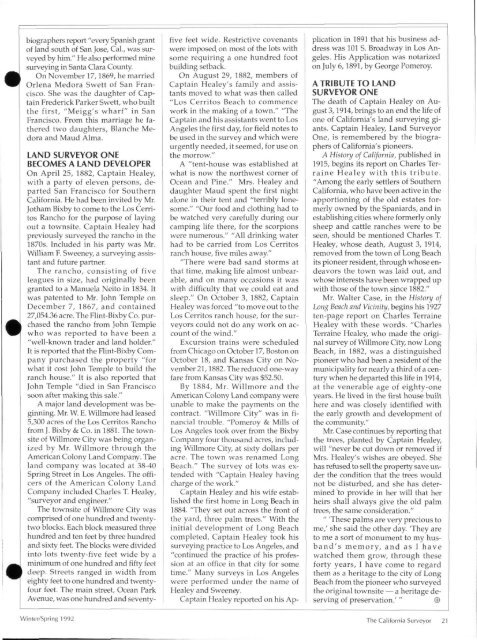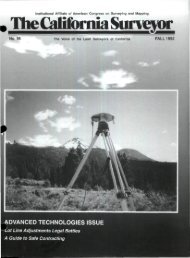Create successful ePaper yourself
Turn your PDF publications into a flip-book with our unique Google optimized e-Paper software.
Jflfe<br />
^ ^<br />
^ ^<br />
^ ^<br />
^ ^<br />
^B<br />
biographers report "every Spanish grant<br />
of land south of San Jose, Cal., was surveyed<br />
by him." He also per<strong>for</strong>med mine<br />
surveying in Santa Clara County.<br />
On November 17, 1869, he married<br />
Orlena Medora Swett of San Francisco.<br />
She was the daughter of Captain<br />
Frederick Parker Swett, who built<br />
the first, "Meigg's wharf" in San<br />
Francisco. From this marriage he fathered<br />
two daughters, Blanche Medora<br />
and Maud Alma.<br />
LAND SURVEYOR ONE<br />
BECOMES A LAND DEVELOPER<br />
On April 25, 1882, Captain Healey,<br />
with a party of eleven persons, departed<br />
San Francisco <strong>for</strong> Southern<br />
Cali<strong>for</strong>nia. He had been invited by Mr.<br />
Jotham Bixby to come to the Los Cerritos<br />
Rancho <strong>for</strong> the purpose of laying<br />
out a townsite. Captain Healey had<br />
previously surveyed the rancho in the<br />
1870s. Included in his party was Mr.<br />
William F. Sweeney, a surveying assistant<br />
and future partner.<br />
<strong>The</strong> rancho, consisting of five<br />
leagues in size, had originally been<br />
granted to a Manuela Neito in 1834. It<br />
was patented to Mr. John Temple on<br />
December 7, 1867, and contained<br />
27,054.36 acre. <strong>The</strong> Flint-Bixby Co. purchased<br />
the rancho from John Temple<br />
who was reported to have been a<br />
"well-known trader and land holder."<br />
It is reported that the Flint-Bixby Company<br />
purchased the property "<strong>for</strong><br />
what it cost John Temple to build the<br />
ranch house." It is also reported that<br />
John Temple "died in San Francisco<br />
soon after making this sale."<br />
A major land development was beginning.<br />
Mr. W. E. Willmore had leased<br />
5,300 acres of the Los Cerritos Rancho<br />
from J. Bixby & Co. in 1881. <strong>The</strong> townsite<br />
of Willmore City was being organized<br />
by Mr. Willmore through the<br />
American Colony Land Company. <strong>The</strong><br />
land company was located at 38-40<br />
Spring Street in Los Angeles. <strong>The</strong> officers<br />
of the American Colony Land<br />
Company included Charles T Healey,<br />
"surveyor and engineer."<br />
<strong>The</strong> townsite of Willmore City was<br />
comprised of one hundred and twentytwo<br />
blocks. Each block measured three<br />
hundred and ten feet by three hundred<br />
and sixty feet. <strong>The</strong> blocks were divided<br />
into lots twenty-five feet wide by a<br />
minimum of one hundred and fifty feet<br />
deep. Streets ranged in width from<br />
eighty feet to one hundred and twentyfour<br />
feet. <strong>The</strong> main street, Ocean Park<br />
Avenue, was one hundred and seventyfive<br />
feet wide. Restrictive covenants<br />
were imposed, on most of the lots with<br />
some requiring a one hundred foot<br />
building setback.<br />
On August 29, 1882, members of<br />
Captain Healey's family and assistants<br />
moved to what was then called<br />
"Los Cerritos Beach to commence<br />
work in the making of a town." "<strong>The</strong><br />
Captain and his assistants went to Los<br />
Angeles the first day, <strong>for</strong> field notes to<br />
be used in the survey and which were<br />
urgently needed, it seemed, <strong>for</strong> use on<br />
the morrow."<br />
A "tent-house was established at<br />
what is now the northwest corner of<br />
Ocean and Pine." Mrs. Healey and<br />
daughter Maud spent the first night<br />
alone in their tent and "terribly lonesome."<br />
"Our food and clothing had to<br />
be watched very carefully during our<br />
camping life there, <strong>for</strong> the scorpions<br />
were numerous." "All drinking water<br />
had to be carried from Los Cerritos<br />
ranch house, five miles away."<br />
"<strong>The</strong>re were bad sand storms at<br />
that time, making life almost unbearable,<br />
and on many occasions it was<br />
with difficulty that we could eat and<br />
sleep." On October 3, 1882, Captain<br />
Healey was <strong>for</strong>ced "to move out to the<br />
Los Cerritos ranch house, <strong>for</strong> the surveyors<br />
could not do any work on account<br />
of the wind."<br />
Excursion trains were scheduled<br />
from Chicago on October 17, Boston on<br />
October 18, and Kansas City on November<br />
21,1882. <strong>The</strong> reduced one-way<br />
fare from Kansas City was $52.50.<br />
By 1884, Mr. Willmore and the<br />
American Colony Land company were<br />
unable to make the payments on the<br />
contract. "Willmore City" was in financial<br />
trouble. "Pomeroy & Mills of<br />
Los Angeles took over from the Bixby<br />
Company four thousand acres, including<br />
Willmore City, at sixty dollars per<br />
acre. <strong>The</strong> town was renamed Long<br />
Beach." <strong>The</strong> survey of lots was extended<br />
with "Captain Healey having<br />
charge of the work."<br />
Captain Healey and his wife established<br />
the first home in Long Beach in<br />
1884. "<strong>The</strong>y set out across the front of<br />
the yard, three palm trees." With the<br />
initial development of Long Beach<br />
completed, Captain Healey took his<br />
surveying practice to Los Angeles, and<br />
"continued the practice of his profession<br />
at an office in that city <strong>for</strong> some<br />
time." Many surveys in Los Angeles<br />
were per<strong>for</strong>med under the name of<br />
Healey and Sweeney.<br />
Captain Healey reported on his Application<br />
in 1891 that his business address<br />
was 101 S. Broadway in Los Angeles.<br />
His Application was notarized<br />
on July 6,1891, by George Pomeroy.<br />
A TRIBUTE TO LAND<br />
SURVEYOR ONE<br />
<strong>The</strong> death of Captain Healey on August<br />
3,1914, brings to an end the life of<br />
one of Cali<strong>for</strong>nia's land surveying giants.<br />
Captain Healey, Land <strong>Surveyor</strong><br />
One, is remembered by the biographers<br />
of Cali<strong>for</strong>nia's pioneers.<br />
A History of Cali<strong>for</strong>nia, published in<br />
1915, begins its report on Charles Terraine<br />
Healey with this tribute.<br />
"Among the early settlers of Southern<br />
Cali<strong>for</strong>nia, who have been active in the<br />
apportioning of the old estates <strong>for</strong>merly<br />
owned by the Spaniards, and in<br />
establishing cities where <strong>for</strong>merly only<br />
sheep and cattle ranches were to be<br />
seen, should be mentioned Charles T.<br />
Healey, whose death, August 3, 1914,<br />
removed from the town of Long Beach<br />
its pioneer resident, through whose endeavors<br />
the town was laid out, and<br />
whose interests have been wrapped up<br />
with those of the town since 1882."<br />
Mr. Walter Case, in the History of<br />
Long Beach and Vicinity, begins his 1927<br />
ten-page report on Charles Terraine<br />
Healey with these words. "Charles<br />
Terraine Healey, who made the original<br />
survey of Willmore City, now Long<br />
Beach, in 1882, was a distinguished<br />
pioneer who had been a resident of the<br />
municipality <strong>for</strong> nearly a third of a century<br />
when he departed this life in 1914,<br />
at the venerable age of eighty-one<br />
years. He lived in the first house built<br />
here and was closely identified with<br />
the early growth and development of<br />
the community."<br />
Mr. Case continues by reporting that<br />
the trees, planted by Captain Healey,<br />
will "never be cut down or removed if<br />
Mrs. Healey's wishes are obeyed. She<br />
has refused to sell the property save under<br />
the condition that the trees would<br />
not be disturbed, and she has determined<br />
to provide in her will that her<br />
heirs shall always give the old palm<br />
trees, the same consideration."<br />
' '<strong>The</strong>se palms are very precious to<br />
me,' she said the other day. '<strong>The</strong>y are<br />
to me a sort of monument to my husband's<br />
memory, and as I have<br />
watched them grow, through these<br />
<strong>for</strong>ty years, I have come to regard<br />
them as a heritage to the city of Long<br />
Beach from the pioneer who surveyed<br />
the original townsite — a heritage deserving<br />
of preservation.' " ©<br />
Winter/Spring 1992 <strong>The</strong> Cali<strong>for</strong>nia <strong>Surveyor</strong> 21
















